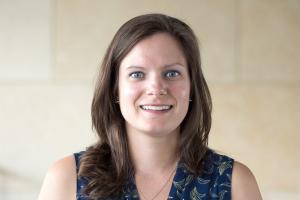
In July 2024, UVA Engineering will welcome Kelsey Kubelick as an assistant professor of biomedical engineering. Kubelick brings an interest in “theranostics,” a research discipline that blends diagnostics with therapies. She has explored the subject in her use of ultrasound, photoacoustic and magnetic resonance imaging to guide and improve design of new therapies.
Kubelick studied biology as an undergraduate at the University of Chicago and earned her Ph.D. from the Georgia Institute of Technology, where she was a member of the Ultrasound Imaging and Therapeutics Research Laboratory led by Stanislav Emelianov. After graduating in 2020, she continued to work at the lab as a postdoctoral researcher and teaching fellow. Under Emelianov’s mentorship, Kubelick developed imaging platforms that could track stem cells during regenerative therapies, which heal or replace damaged organs or tissue.
Kubelick then applied the tracking technology to immunology projects. She began developing techniques for monitoring T cells — a type of white blood cell critical to generating an immune response — during adoptive cell therapy. This immunotherapy involves collecting a patient’s T cells, stimulating their growth in a lab over time, and injecting them back into the body to boost the immune response to invading cancer cells. As a Ph.D. student and postdoctoral researcher, Kubelick developed imaging technology that could closely track those cells post-transfer in preclinical studies.
She will continue that work at UVA, expanding her focus to using imaging tools not only to locate T cells after they’ve been transferred, but to pin down their efficacy as they attack cancer cells. She aims to eventually apply these approaches for T cell monitoring to other therapies as well.
“Right now, we are able to gather information that tells us where the cells are going,” Kubelick said. “That’s the first step. You need to know their location first, to see if they have arrived at the treatment target, and if they have infiltrated and are sticking around. But we don’t know the functional status of those T cells. That’s our next step. Can we see if the T cells are alive? Are they causing a positive antitumor response? Are they inducing harmful side effects?”
Kubelick focuses mainly on photoacoustic imaging, which generates acoustic signals by illuminating optical absorbers with light from laser pulses. When tracking cells, however, most cells — T cells included — don’t generate a photoacoustic signal on their own. They need to first be tagged with an optical absorber, such as nanoparticles, Kubelick said.
She sees the development of nanoparticles, or more broadly, functional nanoconstructs, as a key avenue for advancing imaging technologies for cell tracking. When linked to cells, nanoparticles absorb light to generate the signal needed to locate the cells. Scientists or clinicians can then follow the tagged cells, and from there, observe their efficacy, Kubelick explained. Once the nanoparticle-tagged T cells arrive at a tumor, for instance, they can observe whether or not the T cells kill off cancer cells.
Once these details of cells’ functional status are visible, it’s possible to use light, sound and nanoparticles in imaging to modify the behavior of cells, Kubelick said. Light or sound can be used as a heat source, for instance, to which cells are engineered to respond.
“By modifying cells with nanoparticles or genetic modifications, we can engineer a particular response when a cell ‘feels’ the trigger,” Kubelick said. “Pairing with image guidance, we can monitor the cells, and then understand the best time to trigger the behavior. By applying the trigger at the right time and the right place, we can improve therapy while minimizing off target effects. In the context of immunotherapy, perhaps we visualize accumulation of transferred T cells at the primary tumor and then provide the trigger signal that enhances T cell killing.”
Kubelick plans to explore this potential for modifying cell behavior while at UVA.
Kubelick’s decision to come to UVA crystallized at the Emerging Leaders in Biomedical Engineering Symposium, where she saw the potential to collaborate with researchers across a wide range of disciplines, including focused ultrasound and magnetic resonance imaging; tissue engineering and biomaterials; gene and drug delivery; and neuroscience at the UVA Brain Institute.
“I just had such a wonderful experience,” Kubelick said. “I loved it. I was excited about exploring future opportunities at UVA, the different ways my research could fit with the department, and potential collaborations. I liked that I would also be able to make connections with UVA Health.”
At UVA, Kubelick also hopes to work with students on ways to apply innovation in biomedical engineering to global health. At Georgia Tech, she designed a capstone course around the development of sustainable, robust and inexpensive medical devices for resource-limited settings.
“I want to get these different research and teaching interests aligned as I’m moving forward, and UVA will be a great fit to do this,” Kubelick said.